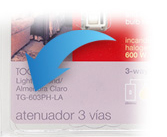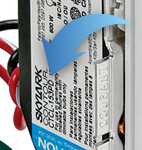
Explore Knowledge Articles
Determining and Troubleshooting QS Link Noise
Link Noise refers to any electrical signals transmitted from the Mux or Muxbar cables of a QS link to the Processor that do not carry meaningful or relevant system information. While some level of Link Noise is normal, depending on the system design, it should remain consistent and not increase over time.
Skip To: Symptoms of Link Noise | How Does Link Noise Work? | How to Determine the Source of the Link Noise | Best Practices
Symptoms of Link Noise
Link Noise doesn't typically cause immediate problems. Instead, it often builds up gradually over time, potentially leading to issues during future site visits. Especially when performing data transfers or system activations.
There are a variety of symptoms that could indicate a Link Noise issue:
- Scrolling ("Reverse Waterfalling") keypads
- Unresponsive devices on the QS link
- Shade Power Panel blink codes (Usually regarding the Diagnostic LED)
- Inability to connect via the app
- Inability to transfer to the system
- Having various devices fail during the transfer that should be responding, or are responding via the Diagnostic Tab
- Link Health indicators on the processor are blinking yellow or red
- Shades randomly throwing a solid red light blink code
How Does Link Noise Work?
Link Noise occurs for a variety of reasons. Some common causes are listed below:
- Somewhere in the QS link, the 3 and 4 wires (Mux and Muxbar) got swapped. This commonly happens on Wire Landing Boards.
- A device is currently in an error state. This can be seen via a blink code on most devices (Such as a blinking light next to the output of a QSPS-10PNL shade panel, or all lights on a Seetouch keypad blinking indicating it's in Boot Mode.)
- A short has occurred between the 1 or 2 wires with either the 3 or 4 wires. This is commonly caused by a stray strand making contact with a phoenix connector.
To determine whether Link Noise is the cause of an issue, in addition to observing the symptoms mentioned above, you can use the Terminal feature in Lutron Designer to check the Link Noise count for the specific link. This count is cumulative. It will not decrease unless the processor is power cycled, or a transfer, firmware upgrade, or factory reset is performed.
Follow the steps below to see your noise level:
- Open Terminal by going to Tools > Terminal
- Select your processor's IP address at the top drop-down menu and select Connect
- At the bottom of the window, select the Command drop-down and select Processor > Processor Link Health. Note: You may need to press the + icon to expand the Processor to access the Processor Link Health Option
- Select the Link you suspect may have Link Noise
- Press Send.
A response is returned with a variety of Link Health values seen below:
The last line is the most important, as it displays the NoiseError count, along with other errors that are usually present with Noise.
Descriptions of each error are found by hovering over them on the Lutron Connect Portal, as well as below:
-
- Noise: Data was not consistent.
- Overrun: Data could not be processed in time.
- Framing: Data detected was not valid.
You can also use the Lutron Connect Portal to view the Link Noise present on the link within the System Monitor. For more details, review the Lutron Connect Portal knowledge article.
For Homeworks QS, the above features are not available; however, there is a command you can use in Terminal similar to QSX.
- Open Terminal and type the command: #MONITORING,255,1 (This allows the terminal to display the response the Processor will give for commands).
- Type in the following command: QSREQUESTLINKSTATUS,[link number]
- The response will be smaller than above, but you will get a similar response showing the Overrun and Noise error count.
- If you accidentally type in a Link number for an RF link, you will receive an error similar to the image below:
How to Determine the Source of the Link Noise
Link noise can be tedious to track down, as the system cannot pinpoint the source of the noise. However, some steps can be taken to make it easier to track down.
A few things to note beforehand:
- Link noise is cumulative. This means it will usually never lower unless the processor or link is restarted.
- Having Link Noise that does not change is fairly normal for all systems. Increasing Link Noise is not normal.
- If Keypads are connected to a link with no other devices on the system to control (such as dimmers or Din-Rail Modules), there should almost always be 0 Link noise.
- Having a link separated into loops using a Wire Landing Board is a best practice that will make this process much easier.
In general, we recommend following these steps to narrow down the source of the noise:
- Disconnect the link from the processor showing symptoms of Link Noise
- Power cycle the processor to reset the Link Noise count to 0
- Use Terminal to verify the Link Noise has remained at 0.
- Starting with devices such as shades and Din-Rail modules, plug in one group at a time and monitor the Link Noise via the Terminal commands
- Minor jumps in link noise is normal when reconnecting these devices, as they are communicating out to the system again.
- If the Link Noise stays steady after a few minutes from reconnecting, plug in the next group of devices.
- Once you've located a group that is causing a consistent growth of Link Noise, disconnect that group and power cycle the processor to 0 out the Link Noise counter again.
- Disconnect all devices except one in the problem group and reconnect the link.
- Monitor the Link Noise again to see which device causes a growth in the noise counter.
- Once the device(s) are located, verify the wiring or use a test wire to verify if it's the device or wiring causing the noise.
- If a replacement is needed under warranty, ensure you generate a Support File from the system before contacting us; we'll be able to verify the device via serial number and see the troubleshooting done to approve the replacement.
Best Practices
Below are recommended practices to avoid Link Noise when wiring a QS link, or to make troubleshooting it easier:
- Separate devices into 'loops' that can be disconnected in groups.
- Wire Landing boards are great for keeping track of loops; however, make sure you only have one loop per landing.
- After finishing a project, it's always a good idea to check the Link Health via Terminal to see if there's any climbing link noise
- Link Noise is not always present immediately. Typically, it will slowly cause issues over time, or when next on-site transferring/firmware upgrading.
- After installation, and before and after activation, make sure to check any panelized devices for error codes
- For shade panels, ensure the output lights are solid and the diagnostic light is on or flashing
- For din-rail modules, ensure the zone lights are not displaying any blink codes. To verify what the blink codes mean, please see their respective installation guides.


